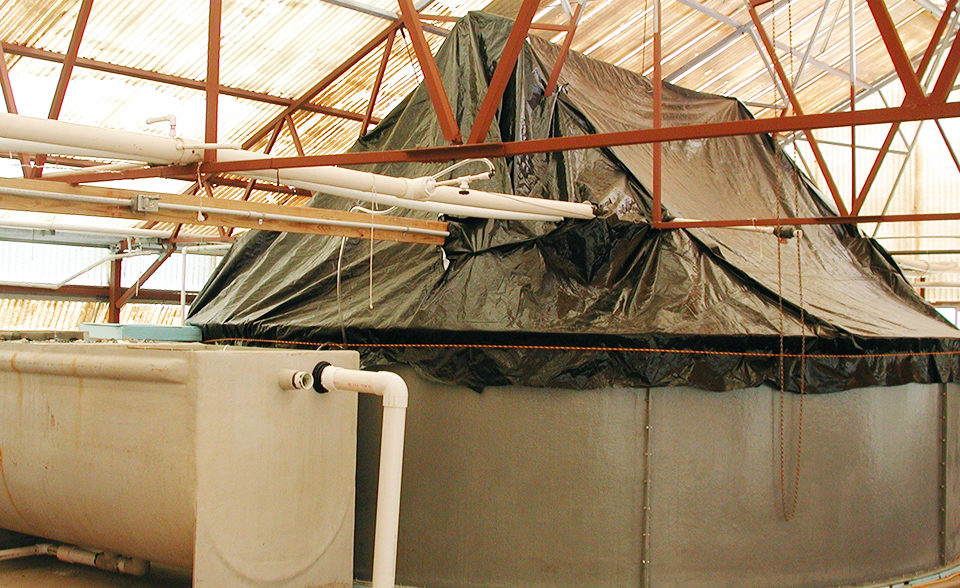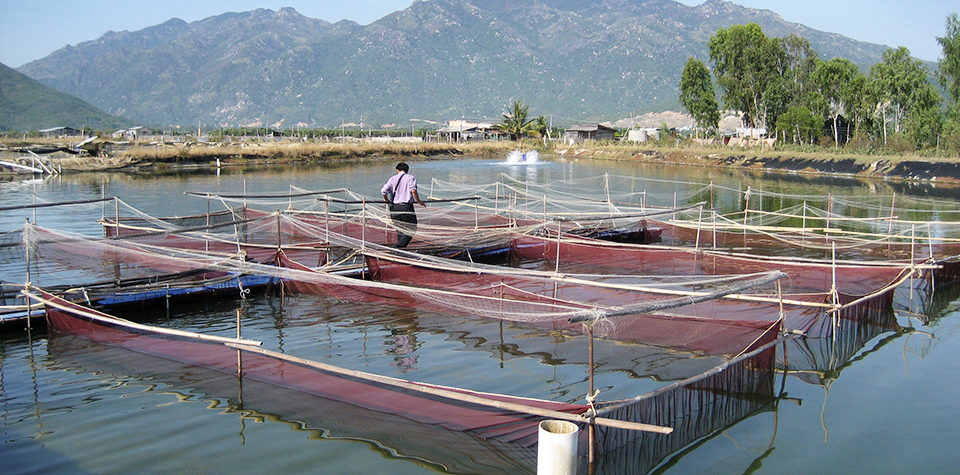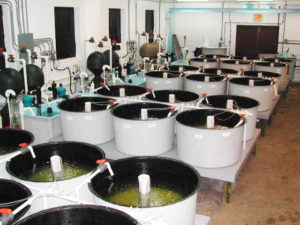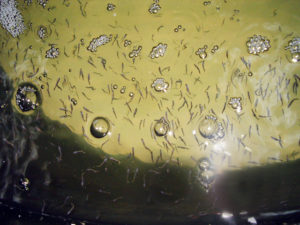Methods vary in Asia versus the Americas

With the global culture of cobia on the upswing, effective methods for large-scale seedstock production are required to meet the growing demand. Production systems for cobia larvae vary greatly around the world. While Asia’s largely extensive approaches are effective, more intensive methods are used in the Americas.
Broodstock management in Asia
Several strategies for the management of cobia broodstock are applied in Asia. The simplest is to keep the breeders in net cages and then transfer matured/ovulated fish to cages lined with a fine-mesh net for egg collection. Hormone induction is sometimes used to facilitate this process. Broodstock stay for only a few days in the spawning cages and are quickly replaced with others after spawning. The number of broodstock in such lined cages can range from five to 20.
Spawning seasons vary depending on the climatic zone. At a fully tropical site, nine or 10 months of spawning can be achieved – only stopped by a possible monsoon. At a more subtropical site, a late-spring spawning peak is typically followed by a smaller autumn peak.
In Taiwan, broodfish are kept in large shore-based tanks. Even in cooler areas, this approach allows 8 to 10 months per year of egg production.
Broodstock management in the Americas
In the Americas, broodstock are maintained in intensive indoor recirculating tank systems with photothermal manipulation. Photothermal cycles typically range from four to six months, followed with as many months of spawning.
In temperate regions, some broodstock facilities maintain outdoor recirculating systems with natural photothermal cycling and spawning. The broodstock are combinations of wild-harvested fish up through f-2 generation captive brooders. Most facilities still rely heavily upon wild-capture brooders, with varying results from the f-1 and f-2 animals. The current trend is to forgo larger fish, emphasizing greater inventories of smaller broodstock in the 5- to 12-kg range.

Larviculture strategies in Asia

In Asia, the range of culture strategies for cobia varies widely, from the very intensive “Western-style” to the more common use of induced natural production of copepods and rotifers in larger ponds. The most extensive method involves inducing an algae bloom in a simple earthen pond and stocking newly hatched cobia larvae in the pond as the bloom matures, resulting in extensive copepod production. Additional cope-pods are added from collection in nets suspended downstream from paddlewheels in operating shrimp ponds.
This method is clearly extensive and low-cost in nature, producing many thousands of fingerlings with minimal labor investment. It can give quite reproducible results of large volumes of fast-growing fingerlings for experienced operators. However, the fingerlings often suffer from infections caused by parasites, both due to host fauna in the earthen ponds and the common practice of final feeding or weaning with chopped trash fish.
A more controlled strategy simulates the aforementioned technique, but involves the use of large concrete tanks or ponds. These tanks can be cleared of parasite host animals and allow greater control of environmental parameters. The tanks are often used in conjunction with greenhouse roofing to avoid problems from rainfall or sudden low temperatures.
In this approach, copepods and rotifers are produced in separate large dedicated concrete ponds previously stocked with rotifers from intermediate cultures. The copepods still originate from natural blooms.
When the fry enter the weaning stage, they are transferred to smaller nursery-style tanks, where co-feeding is initiated in conjunction with artemia and commercial feeds. This strategy combines the nutritional advantages of the copepods from extensive production with enhanced health and safety in a more controlled environment.
Larviculture strategies in the Americas

In the Americas, the majority of cobia larviculture is conducted in tanks. This tank production ranges from extensive outdoor applications to intensive indoor recirculating systems with complete environmental and biological control. Extensive larviculture production yields an average one to two fingerlings per liter, incorporating a range of live feed production from extensive to intensive. Intensive larviculture production yields three to five fingerlings per liter with all live feeds originating from intensive indoor, biosecure production systems.
The following is the present intensive larviculture production protocol developed by the International Initiative for Sustainable and Biosecure Aquafarming and currently in use at Virginia Tech’s Virginia Seafood Agricultural Research and Extension Center (VSAREC) in Hampton, Virginia, USA. Larviculture production tanks of 300-l volume are connected in threes to an intensive recirculating system that combines biofiltration, mechanical filtration with bead and bag filters, ultraviolet sterilization, protein skimming, temperature control, aeration and flow control into each tank. Eight such systems can be operated individually or linked in varying configurations.
Tank turnover within each system depends upon the larviculture stage, ranging from 4 turnovers/day at the beginning to as high as 1 turnover/hour during the final cofeeding and weaning stage.
Each tank is initially stocked with 15, two-day-posthatch (dph) sac fry per liter. Feedings throughout the larviculture period are conducted every six hours. Rotifers are added 2-9 dph, starting at 1.0 per ml and increasing to 2.5 per ml. During the rotifer stage, Nannochloropsis algae are also added. At 7 to 10 dph, small-strain unenriched artemia are fed at 0.5 to 1.0 per ml. Enriched artemia are then fed at 0.5 to 3.5 per ml during the 10 to 20 dph period.
From 15 to 20 dph, cofeeding commences at 15-minute intervals beginning one hour before each live feeding event. For 20-23 dph, enriched artemia are reduced 1 per ml per day, while weaning diets are added at 30-minute intervals beginning three hours before each live feed event. At the completion of 23 dph, the fish are weaned, maintained on dry diets and ready for transfer to phase-rearing production systems.
Environmental parameters during larviculture include temperatures of 28 to 29 degrees-C and 24-hour light at 250-300 lux. Salinity of 34 ppt is reduced 1 ppt daily down to 22 ppt. Dissolved-oxygen concentrations are maintained at 7 to 8 ppm, with alkalinity at 150-200 mg/l. pH measures 8.1 to 8.2, and total ammonia nitrogen is kept below 0.01 mg per liter. Systems are backwashed daily, accounting for about 5 percent daily exchange.
(Editor’s Note: This article was originally published in the May/June 2009 print edition of the Global Aquaculture Advocate.)
Now that you've finished reading the article ...
… we hope you’ll consider supporting our mission to document the evolution of the global aquaculture industry and share our vast network of contributors’ expansive knowledge every week.
By becoming a Global Seafood Alliance member, you’re ensuring that all of the pre-competitive work we do through member benefits, resources and events can continue. Individual membership costs just $50 a year. GSA individual and corporate members receive complimentary access to a series of GOAL virtual events beginning in April. Join now.
Not a GSA member? Join us.
Authors
-
Michael H. Schwarz, Ph.D.
Virginia Tech
Virginia Seafood AREC
102 South King Street
Hampton, Virginia 23669 USA -
Niels Svennevig, Ph.D.
Tropical Center
SINTEF Fisheries and Aquaculture
Trondheim, Norway
Tagged With
Related Posts

Health & Welfare
A study of Zoea-2 Syndrome in hatcheries in India, part 2
Indian shrimp hatcheries have experienced larval mortality in the zoea-2 stage, with molt deterioration and resulting in heavy mortality. Authors considered biotic and abiotic factors. Part 2 describes results of their study.

Health & Welfare
Aquaculture in Germany
Germany produces a limited amount of carp, trout, mussels and other species. Although traditional pond-based farms continue to operate, the country’s aquaculture production is trending toward land-based systems that feature efficient resource use and reduced environmental impacts.

Innovation & Investment
Artemia, the ‘magic powder’ fueling a multi-billion-dollar industry
Artemia, microscopic brine shrimp used as feed in hatcheries, are the unsung heroes of aquaculture. Experts say artemia is still inspiring innovation more than 50 years after initial commercialization. These creatures are much more than Sea-Monkeys.

Health & Welfare
Asepsis key to prevent contamination in shrimp hatcheries
Maintaining biosecurity and asepsis in larval shrimp production is a key component of the production chain in Ecuador, which requires the production of 5.5 billion larvae monthly from 300-plus hatcheries.


